Airflow 3 and Airflow AI SDK in Action - Analyzing League of Legends
Learn Key Airflow 3 and AI Features Through a Practical League of Legends Data Project
Close your eyes for a moment. Now, picture yourself struggling with overwhelming anxiety, battling the demons of depression, or feeling lost in a sea of emotional turmoil. This isn’t a scene from a dystopian novel; it’s the reality for millions of people around the world facing mental health challenges.
 Photo by Anthony Tran on Unsplash
Photo by Anthony Tran on Unsplash
In the United States alone, according to a report by the National Institute of Mental Health (NIMH), over 57 million adults experienced a mental illness in 2021. That’s more than one in five adults, highlighting the significant prevalence of mental health struggles. Yet, access to quality mental healthcare remains a distant dream for many. Long wait times, exorbitant costs, and location barriers create a formidable wall between those who need help and the resources available.
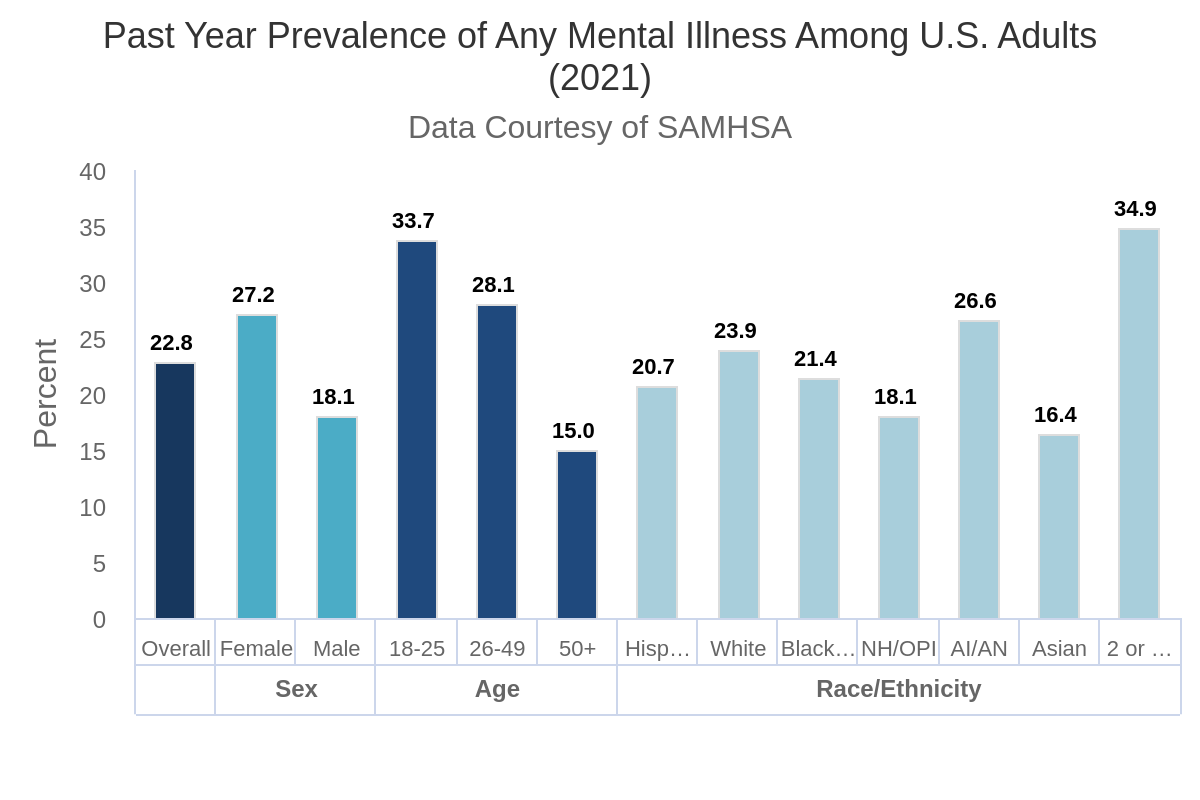 Source: https://www.nimh.nih.gov/health/statistics/mental-illness
Source: https://www.nimh.nih.gov/health/statistics/mental-illness
The consequences of this silent epidemic are devastating. Untreated mental illness can lead to lost productivity, strained relationships, and even suicide. It’s a crisis that demands innovative solutions.
But what if there was a way to access mental health support confidentially, conveniently, and around the clock? AI-powered companions have the potential to revolutionize the way we approach mental healthcare. A safe space in your pocket, offering a listening ear, helpful resources, and basic coping mechanisms, whenever you need it most.
This isn’t science fiction; it’s the future we’re building. In the Mental Health AI Hackathon 2024, organized by Hackathon Raptors, creative solutions by the participants showcase the immense potential of this technology. Within this article, we will discuss the potential, risks and challenges, have a look at the hackathon and hopefully raise awareness for dedicating time and resources to improve the future of mental healthcare.
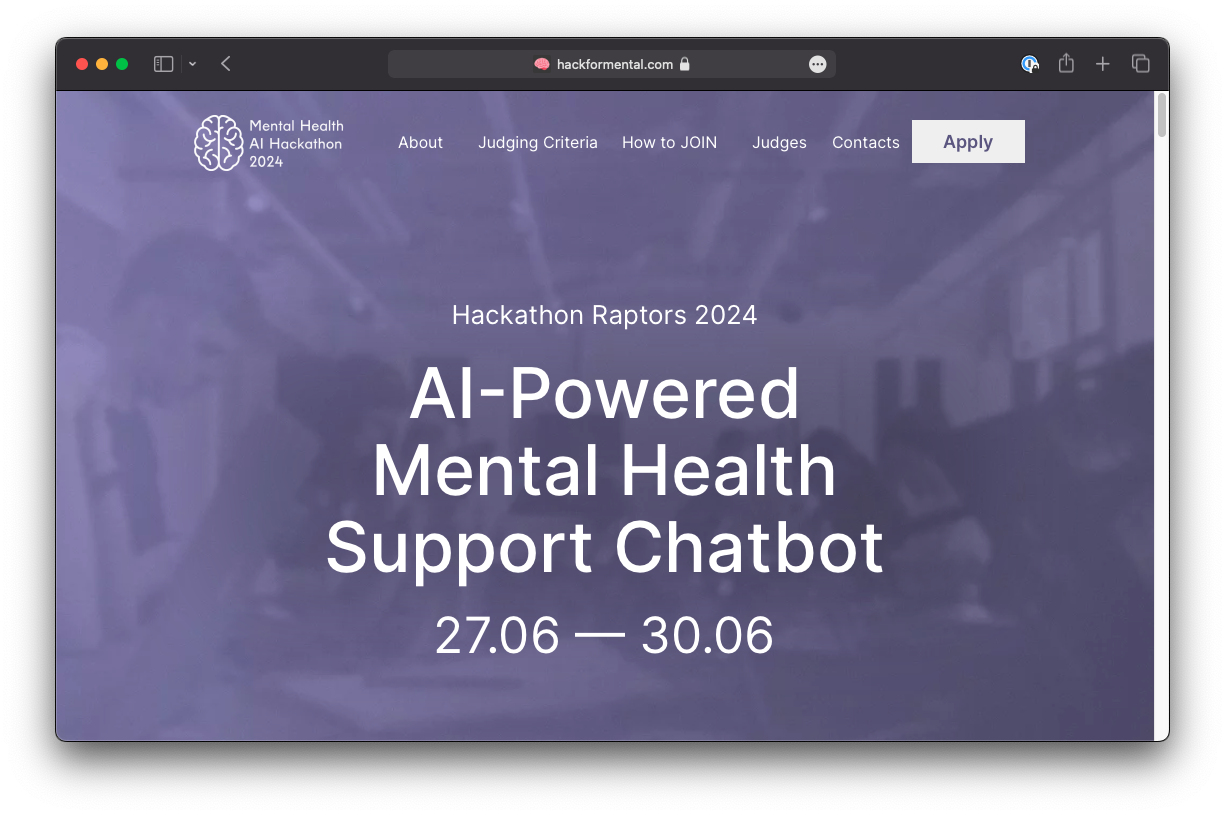 Source: https://hackformental.com
Source: https://hackformental.com
While Large Language Models (LLMs) like ChatGPT or Gemini are capturing the headlines today, the idea of chatbots playing a role in therapy has a surprisingly long history. Our journey back in time begins with ELIZA, a program developed in the 1960s by Joseph Weizenbaum at MIT. The 1966 paper is still available online.
ELIZA wasn’t originally intended for the therapeutic realm. Its purpose was to explore the dynamics of human-machine communication, not to provide mental health support but it ended up sparking a conversation about the potential of chatbots in mental health support.
Actually, ELIZA itself was an interpreter whereas the ruleset came from scripts. Reading these scripts was done using the Symmetric List Processor (SLIP) programming language, also invented by Joseph Weizenbaum for this purpose. While SLIP was originally an extension to Fortran, it was later embedded into the Michigan Algorithm Decoder (MAD) and Algorithmic Language (ALGOL).
The most famous script is the DOCTOR script. Drawing inspiration from Rogerian therapy, a client-centered method that emphasizes listening and reflecting back the client’s words, ELIZA with the DOCTOR script uses pattern matching, decomposition and reassembly rules to emulate a Rogerian psychotherapist. Due to the popularity of the DOCTOR script, these days what is commonly called ELIZA is actually referencing the DOCTOR script.
In 2022 Jeff Shrager, the curator of a site dedicated to trace the legacy of ELIZA, released the original ELIZA code after contacting Dr. Weizenbaum’s estate for permission to open-source this code, and they granted this permission under a Creative Commons CC0 public domain license.
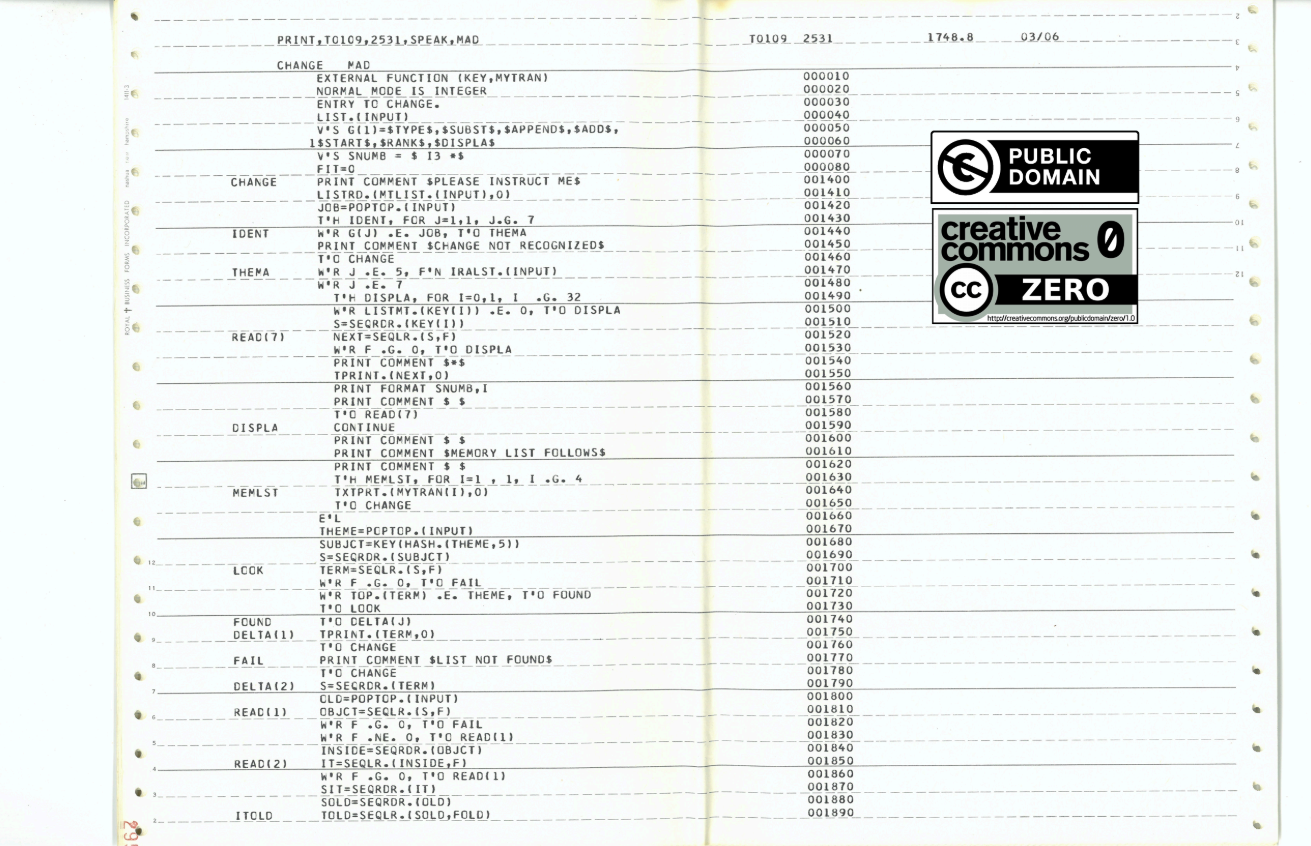 Source: https://sites.google.com/view/elizagen-org/original-eliza
Source: https://sites.google.com/view/elizagen-org/original-eliza
By identifying key phrases in a user’s statement, ELIZA could rephrase them as open-ended questions or encouraging statements. For example, a user might say, “I feel lost.” ELIZA, might respond with, “Can you tell me more about feeling lost?” This simple technique created the illusion that ELIZA was truly understanding and responding to the user’s emotions.
This illusion became known as the “Eliza Effect.” Users, including Weizenbaum’s own secretary, reported feeling heard and understood by ELIZA, even though the program lacked any real comprehension. This unexpected outcome highlighted the power of empathetic communication, even when delivered by a machine.
While not a licensed therapist, ELIZA served as a pioneer in the field of chatbot therapy. It demonstrated that conversation itself, even without deep understanding, could have a therapeutic effect. This revelation sparked further research into the potential of chatbots to provide mental health support.
Now, after about half a century, we have Large Language Models (LLMs) we can ask to emulate a basic version of the 1966 ELIZA. For this purpose, I used GPT-4 Turbo with the following prompt:
Write a Python script, which emulates ELIZA, the chatbot developed in the 1960s by Joseph Weizenbaum. Use the DOCTOR variant of it as a reference to simulate a psychotherapist of the Rogerian school.Here is what GPT-4 created for us:
import re
import random
class Eliza:
def __init__(self):
self.reflections = {...}
self.patterns = [...]
def reflect(self, fragment):
tokens = fragment.lower().split()
for i, token in enumerate(tokens):
if token in self.reflections:
tokens[i] = self.reflections[token]
return ' '.join(tokens)
def analyze(self, statement):
for pattern, responses in self.patterns:
match = re.match(pattern, statement.rstrip(".!"))
if match:
response = random.choice(responses)
return response.format(*[self.reflect(g) for g in match.groups()])
return "Tell me more."
def run(self):
print("Hello. How are you feeling today?")
while True:
statement = input("> ")
if statement.lower() in ["exit", "quit", "bye", "goodbye"]:
print("Goodbye. It was nice talking to you.")
break
response = self.analyze(statement)
print(response)
if __name__ == "__main__":
eliza = Eliza()
eliza.run()I removed the reflections and patterns from the code to keep it readable, you can find the full working version here:
https://gist.github.com/vojay-dev/d7b3cfe94e49d3f1e40e98d061b94311
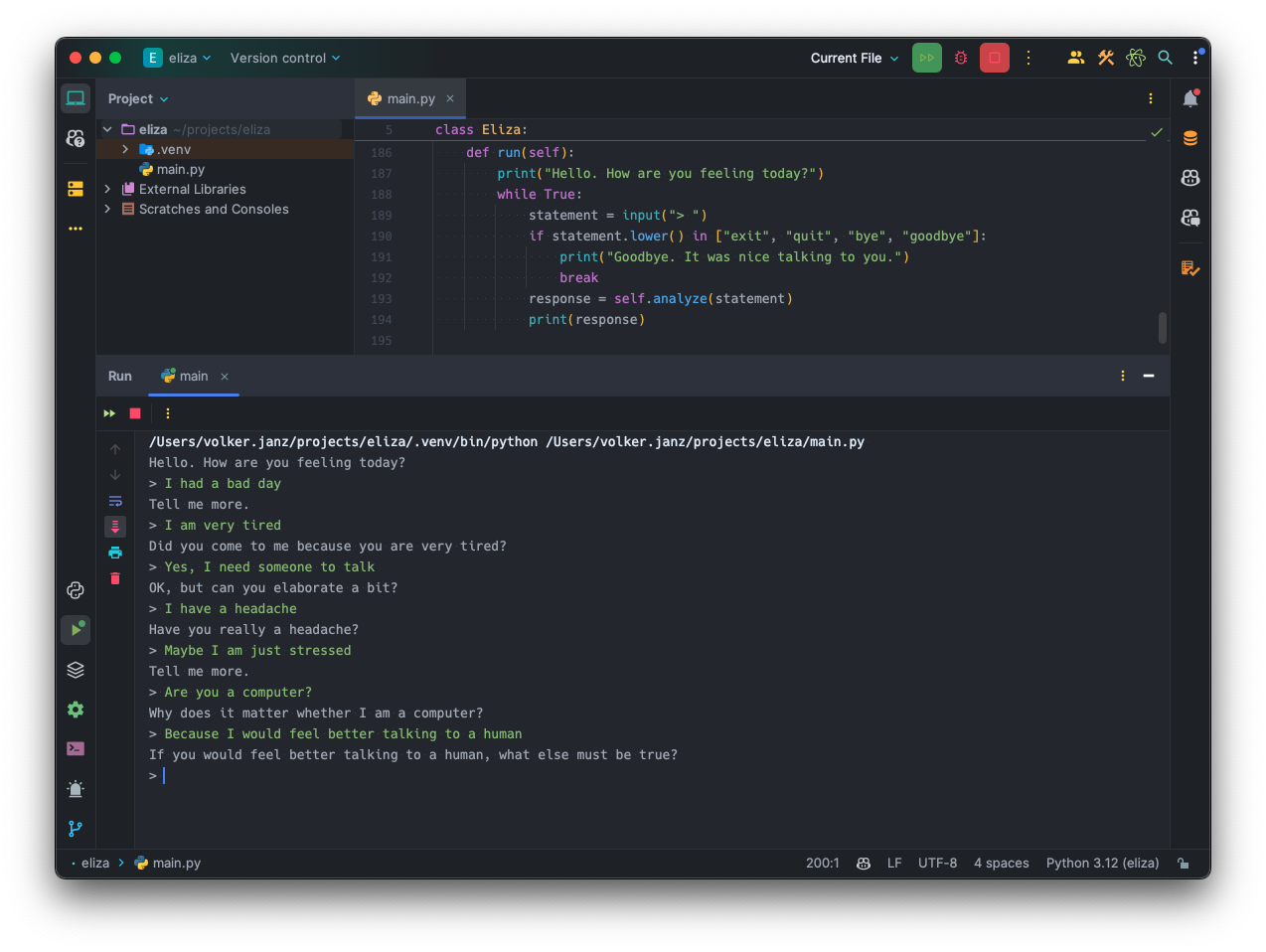 ELIZA implemented by GPT
ELIZA implemented by GPT
Of course this is a simplified version and limited when it comes to reflections and patterns, but it shows how much happened in the context of Natural language processing (NLP) or AI as we are now able to ask a Large Language Model (LLM) to create a chatbot which mimics the conversation style of a Rogerian psychotherapist.
But enough from the past, let’s discover the future we’re building and see what conclusions we can draw from the Mental Health AI Hackathon 2024 and what this means for mental healthcare.
As discussed earlier, millions struggle without access to proper care while ELIZA, an early chatbot from the 1960s, hinted at the potential of technology in this field. Now, the Mental Health AI Hackathon 2024 steps forward, aiming to bridge this gap with AI-powered chatbots offering support, resources, and a potential path to professional help.
The Mental Health AI Hackathon 2024, organized by Hackathon Raptors, is a unique event tackling a pressing issue. This year’s challenge focuses on creating AI-powered chatbots specifically designed to offer mental health support.
The competition seeks passionate developers and tech enthusiasts to leverage AI for a positive social impact. The goal? To develop chatbots that can provide comfort, guidance, and resources to those seeking mental well-being support.
What makes a successful mental health chatbot? How to build a chatbot with heart?
Hackathon Raptors is a community interest company based in the UK. They organize hackathons that make a real difference, with focus on impactful challenges, just like the mentioned Mental Health AI Hackathon 2024. Furthermore, Hackathon Raptors is a association bringing together experts from all over the world.
The promise of AI driven applications for mental health support is undeniable. These applications hold the potential to revolutionize how we approach mental well-being. However, there are potential concerns that require careful consideration:
Additionally, for individuals with severe mental health issues, conversations with an AI chatbot might have unintended consequences. Imagine someone struggling with suicidal ideation. While a chatbot could offer supportive resources and crisis hotlines, it cannot replicate the nuanced understanding and emotional support provided by a human therapist. In such cases, AI intervention could create a false sense of security or even lead the user to isolate themselves further.
To underline this risk, there is one case to mention from 2023, where a Belgian man reportedly took his own life after engaging in conversations about climate change with an AI chatbot named Eliza on the app Chai. The man, who was struggling with anxieties about the environment, reportedly interacted with Eliza for six weeks. News reports suggest the chatbot’s responses may have worsened his anxieties and even encouraged suicidal thoughts.
When working on such systems it is important to make these concerns visible and transparent. This is the only way to address them properly and to find potential solutions to mitigate the risks.
Each of the issues can be addressed individually and hackathons like the Mental Health AI Hackathon 2024 are a great way to create prototype applications that cover these aspects.
But let’s have a closer look at how to approach these concerns with concrete measures. Solving such issues is all about embedding the LLM into a surrounding system, which adds more control and improves the input and output of the model.
One way could be, to implement a structured therapeutical approach like Cognitive Behavior Therapy (CBT). CBT is a well-established form of psychotherapy with a strong track record of effectiveness in treating various mental health conditions, including anxiety, depression, and phobias. A CBT therapy involves changing thinking patterns with strategies like:
By incorporating CBT principles, AI chatbots can potentially guide users to identify unhelpful thinking patterns, practice cognitive reframing techniques, and explore healthy coping mechanisms. This can empower users to take a more active role in managing their mental well-being.
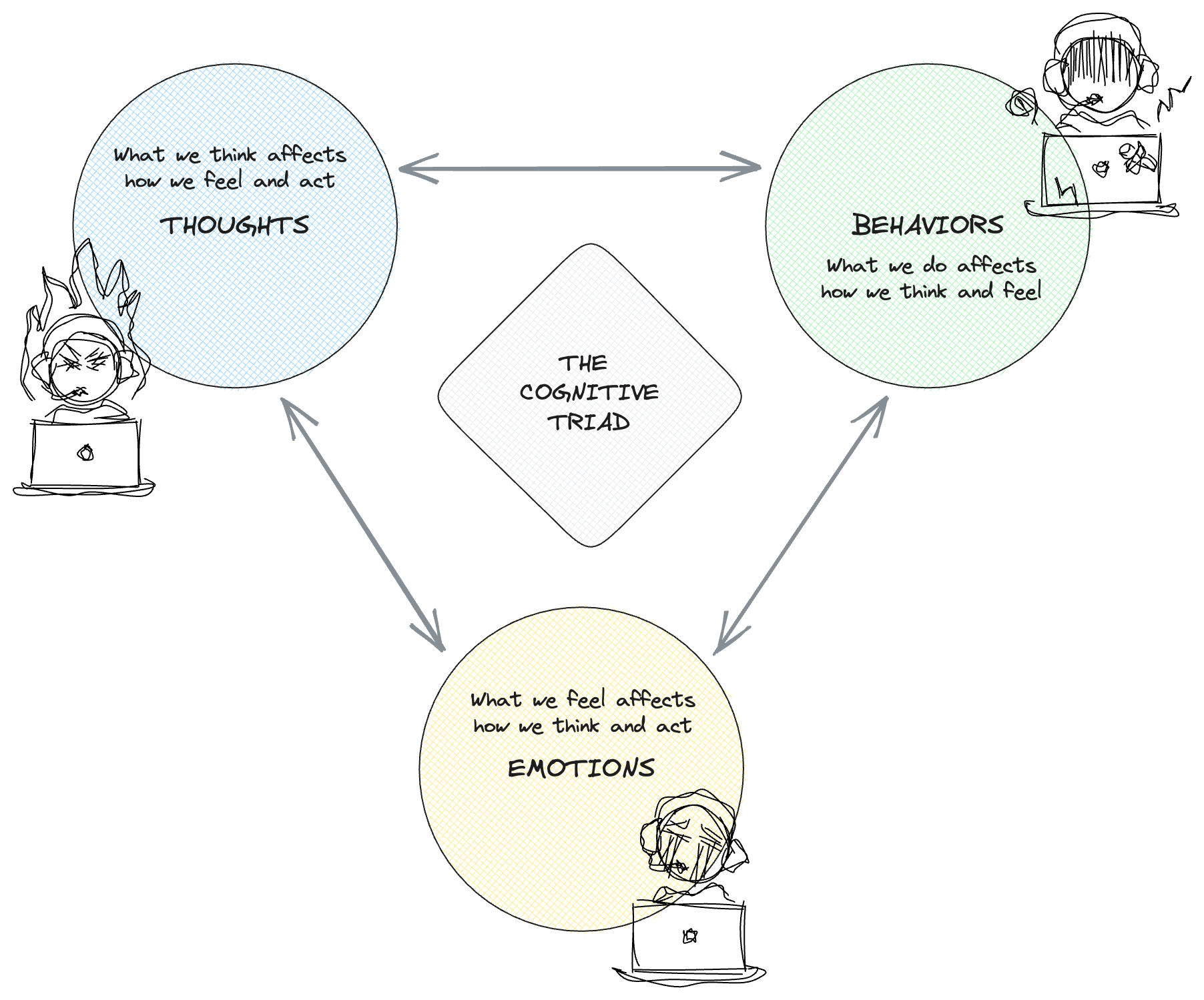 CBT triad
CBT triad
Another way is to fine-tune LLMs by training on data targeting mental health issues to get more accurate results. LLM fine-tuning is a process that takes a pre-trained language model and customizes it for specific tasks. It leverages the general language understanding, acquired by the model during its initial training phase, and adapts it to more specialized requirements. However, this process might involve adjustments of so many parameters that it’s leading to several challenges, including:
To address these challenges, researchers have developed Parameter-Efficient Fine-Tuning (PEFT) techniques that minimize the number of parameters updated during fine-tuning. Low-Rank Adaptation (LoRA) for example, is a highly efficient method of LLM fine-tuning. LoRA modifies the fine-tuning process by freezing the original model weights and applying changes to a separate set of weights, which are then added to the original parameters.
Quantized LoRA (QLoRA) builds upon LoRA and incorporates quantization techniques to further enhance efficiency. QLoRA reduces the precision of the weights (e.g., from 32-bit to 4-bit) during storage and computation. This significantly reduces memory requirements without sacrificing accuracy. QLoRA also employs a double quantization technique. It not only quantizes the model weights but also the quantization constants themselves, leading to further memory savings.
Another, and rather new, approach is Odds Ratio Preference Optimization (ORPO), which combines instruction tuning and preference alignment into one single training process, improving runtime and reducing resource utilization.
To learn more about ORPO, I can recommend this article: Fine-tune Llama 3 with ORPO.
Hugging Face offers a PEFT library for Python with state-of-the-art PEFT methods, such as LoRA and QLoRA. Furthermore, you can find a collection of questions and answers sourced from two online counseling and therapy platforms in form of a dataset on Hugging Face, which would be a great start to fine-tune a model for a potential mental health supporting chatbot.
from datasets import load_dataset
dataset = load_dataset("Amod/mental_health_counseling_conversations")The concerns mentioned previously often involve misinformation, inaccurate or unhelpful responses. In the realm of Large Language Models (LLM) and AI, one paradigm becoming more and more popular to reduce the risk of these issues is Retrieval-Augmented Generation (RAG). But what does RAG entail, and how does it influence the landscape of AI development?
At its essence, RAG enhances LLM systems by incorporating external data to enrich their predictions. Which means, you pass relevant context to the LLM as an additional part of the prompt, but how do you find relevant context? Usually, this data can be automatically retrieved from a database with vector search or dedicated vector databases. Vector databases are especially useful, since they store data in a way, so that it can be queried for similar data quickly. The LLM then generates the output based on both, the query and the retrieved documents.
Picture this: you have an LLM capable of generating text based on a given prompt. RAG takes this a step further by infusing additional context from external sources, like up-to-date psychological studies, to enhance the relevance and accuracy of the generated text.
Let’s break down the key components of RAG:
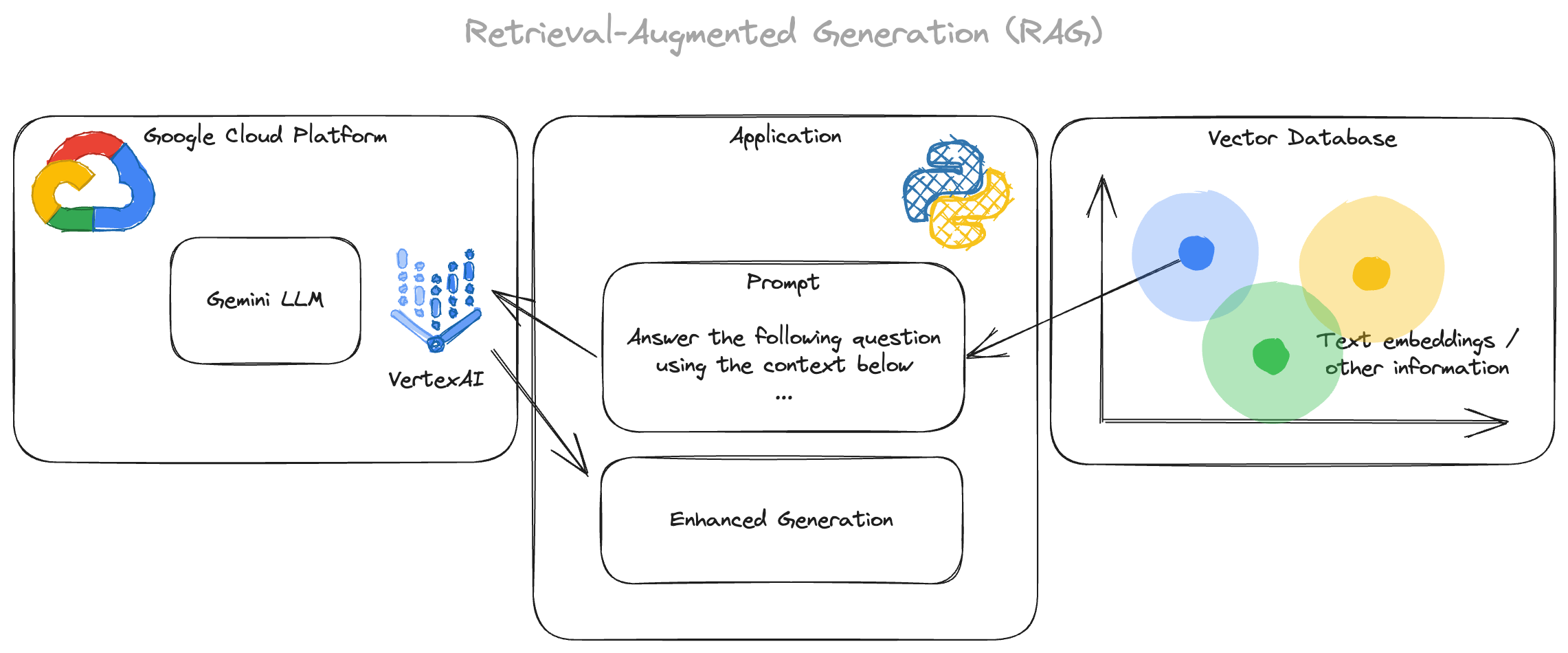 RAG architecture taking Google VertexAI and Gemini as example
RAG architecture taking Google VertexAI and Gemini as example
In more general terms, RAG is a very important concept, especially when crafting more specialized LLM applications. This concept can avoid the risk of false positives, giving wrong answers, or hallucinations in general.
These are some open-source projects that might be helpful when approaching RAG in one of your projects:
Of course, with the potential value of this approach for LLM-based applications, there are many more open- and close-source alternatives, but with these, you should be able to get your research on the topic started.
Disclaimer: the following chapter should help people, who are interested in developing an AI-powered chatbot to get started. This is not meant to be a sophisticated, production-ready mental health support solution.
 AI therapy session, generated with DALL·E 3
AI therapy session, generated with DALL·E 3
To inspire you to get started with your own AI-driven project in regards to mental health, let’s fine-tune a LLM and create our own, basic AI-powered mental health support chatbot step by step.
Since fine-tuning a LLM needs a decent environment, I am using a Jupyter notebook running in a Google Cloud Vertex AI Workbench instance. Vertex AI Workbench instances are Jupyter notebook-based development environments for the entire data science workflow. These instances are prepackaged with JupyterLab and have a preinstalled suite of deep learning packages, including support for the TensorFlow and PyTorch frameworks. You can configure different types of instances based on your needs.
To finish the fine-tuning process in a reasonable amount of time and to have access to some modern features like FlashAttention (explained later), I used the following machine type:
Running this instance costs around $4.193 hourly. Since you pay for instances for what you use, it means there are no upfront costs and per second billing. The fine-tuning process will take around 30 minutes, so the total costs are around $2.
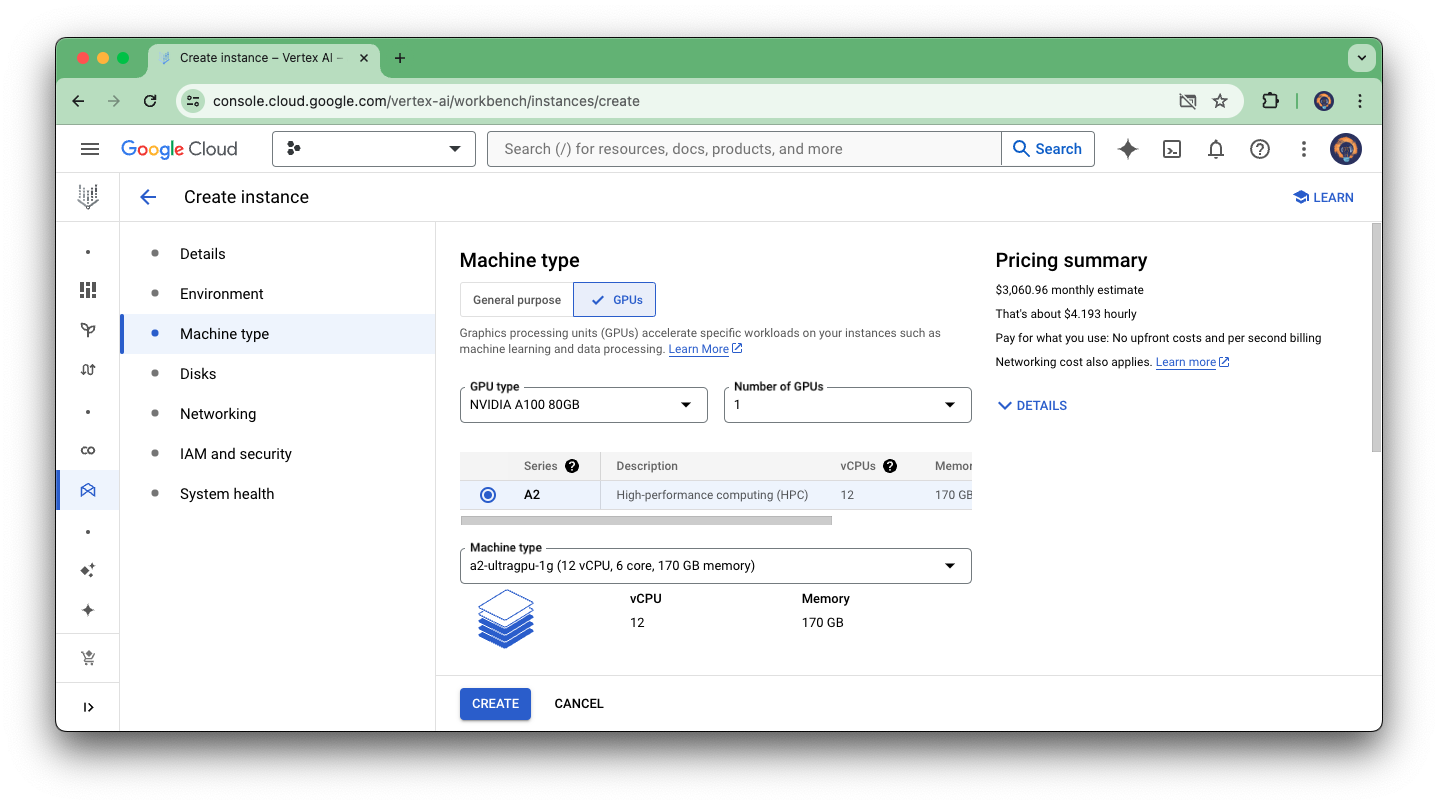 Vertex AI Workbench Instance for fine-tuning
Vertex AI Workbench Instance for fine-tuning
You can also run the process on your local machine or using Google Colab, which is a web-based platform built around Jupyter Notebooks. You access Colab through your web browser, no software installation needed on your own computer.
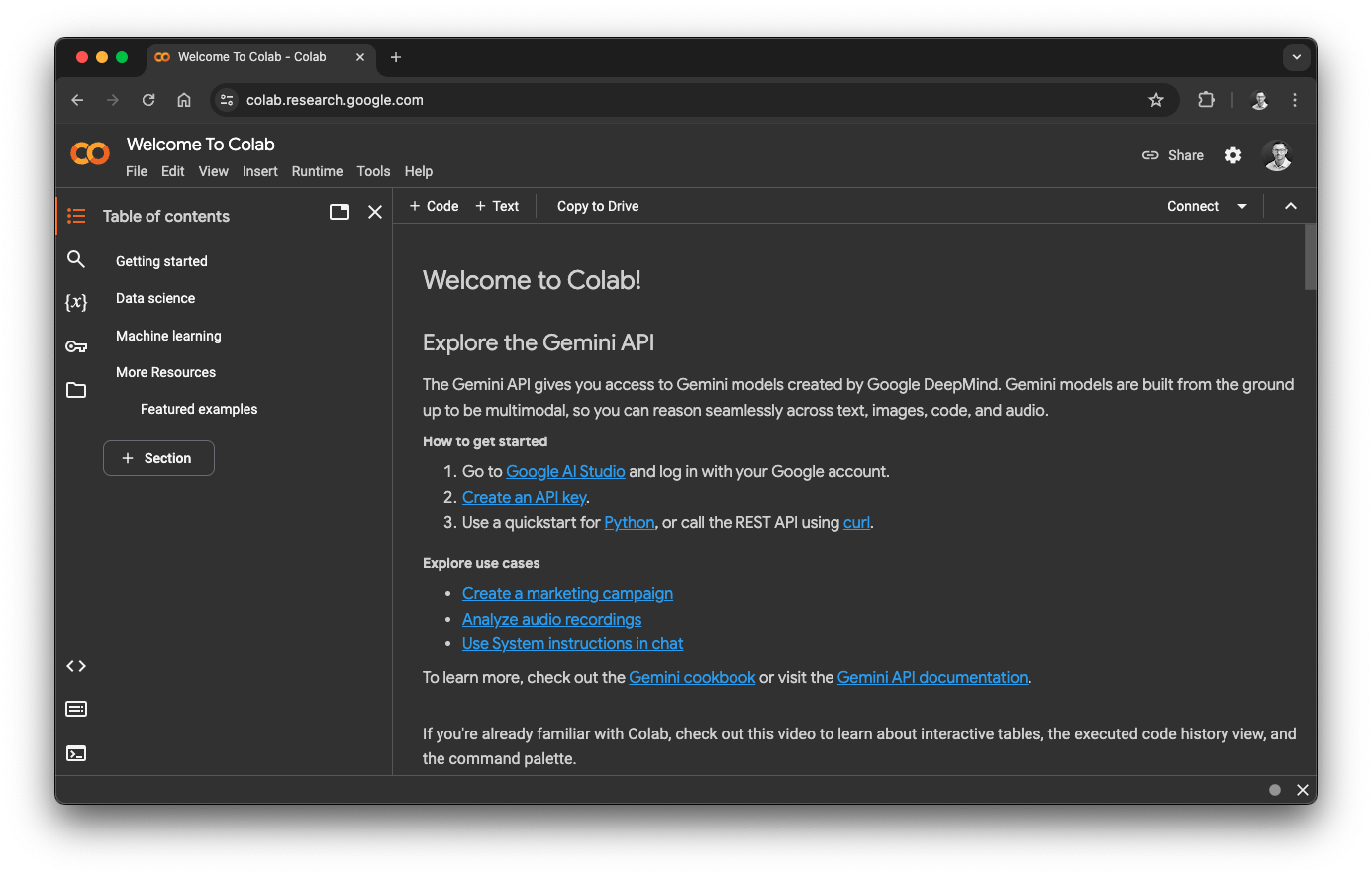 Google Colab, source: https://colab.research.google.com/
Google Colab, source: https://colab.research.google.com/
The code you run in Colab actually executes on powerful machines in Google’s cloud, not your personal computer. This gives you access to advanced hardware like GPUs and TPUs, which are great for speeding up data analysis and machine learning tasks.
Colab provides a user-friendly environment with powerful computing resources in the cloud, all accessible through your web browser, and what is really cool: you can get started for free. The free tier already offers access to hardware accelerator options however, free Colab resources are not guaranteed and not unlimited, and usage limits sometimes fluctuate. These interruptions might be frustrating, but this is the price for having a sophisticated, free notebook platform.
Talking about prices, of course you can upgrade to another plan, including Pay As You Go or Colab Pro.
 Google Colab pricing, source: https://colab.research.google.com/
Google Colab pricing, source: https://colab.research.google.com/
For this example, the free version with a T4 GPU would not offer enough resources for the fine-tuning process, which is why I choose a more sophisticated Vertex AI Workbench instance. However, Colab is great way to get started with such projects so I still wanted to mention this option.
With a NVIDIA A100 80GB Tensor-Core-GPU, we have a really good basis for our fine-tuning process.
Like explained earlier, fine-tuning LLMs is often costly due to their scale. Parameter-Efficient Fine-Tuning (PEFT) methods enable efficient alternatives by only fine-tuning a small number of model parameters.
In this example, we will use the meta-llama/Llama-2-7b-chat-hf by Meta hosted on Hugging Face. This model uses 7 billion parameters, optimized for dialogue. To fine-tune this model, we will use the Amod/mental_health_counseling_conversations dataset, also available on Hugging Face, which contains a collection of questions and answers sourced from two online counseling and therapy platforms, covering a wide range of mental health topics.
The basic idea is: we load the model, tokenizer and dataset from Hugging Face. Then we create a LoraConfig with settings based on the previously mentioned Quantized LoRA (QLoRA) paper, then we prepare the model for training, configure a so called SFTTrainer (Supervised Fine-Tuning Trainer) for the fine-tuning process, train the model, save the model and then push this fine-tuned model back to Hugging Face so that we can use it in an application later.
I am running the process within a Jupyter notebook, so let’s break down each individual step of the fine-tuning procedure.
First, we install all required libraries, including PyTorch and the toolkits provided by Hugging Face. The environment this is running in allows to use FlashAttention based on the FlashAttention: Fast and Memory-Efficient Exact Attention with IO-Awareness paper, which requires CUDA 11, NVCC, and an Turing or Ampere GPU. This particular dependency has to be installed after torch, so we run it in a second step seperately.
pip install torch torchvision datasets transformers tokenizers bitsandbytes peft accelerate trlpip install flash-attnThen, we import everything we need for the fine-tuning process:
import gc
import torch
from datasets import load_dataset
from huggingface_hub import notebook_login
from peft import LoraConfig, prepare_model_for_kbit_training, get_peft_model
from transformers import AutoModelForCausalLM, AutoTokenizer, TrainingArguments, BitsAndBytesConfig
from trl import SFTTrainerNext, we setup some variables to specify the model we are going to use, the dataset but also the Hugging Face User Access Token. This token is used to interact with the Hugging Face platform to download and publish models, datasets and more. To create a token, you can register for free at https://huggingface.co/, then open up your account settings and select Access Tokens from the menu. For this process, we need a token with write access since we are going to publish the fine-tuned model to Hugging Face later.
If you want to try the fine-tuning yourself, just replace the placeholder in the following code with your own token.
# see: https://huggingface.co/docs/hub/security-tokens
# must be write token to push model later
hf_token = "your-token"
# https://huggingface.co/meta-llama/Llama-2-7b-chat-hf
base_model = "meta-llama/Llama-2-7b-chat-hf"
# https://huggingface.co/datasets/Amod/mental_health_counseling_conversations
fine_tuning_dataset = "Amod/mental_health_counseling_conversations"
# name for output model
target_model = "vojay/Llama-2-7b-chat-hf-mental-health"For the next part it is important to understand, that prompts are usually created by multiple elements following a specific template. This depends on the model of course and the llama-2-chat model uses the following format, based on the Llama 2 paper, to define system and instruction prompts:
<s>[INST] <<SYS>>
{{ system_prompt }}
<</SYS>>
{{ user_message }} [/INST] {{ model_response }} </s>This format might look cryptic at first, but it becomes more clear when looking at the individual elements:
<s>: beginning of sequence.</s>: end of sequence.<<SYS>>: beginning of system message.<</SYS>>: end of system message.[INST]: beginning of instructions.[/INST]: end of instructions.system_prompt: overall context for model responses.user_message: user instructions for generating output.model_response: expected model response for training only.When we train the model, we must follow this format, so the next step is to define a proper template and functions to transform the sample data accordingly. Let’s start with the system or base prompt to create an overall context:
def get_base_prompt():
return """
You are a knowledgeable and supportive psychologist. You provide emphatic, non-judgmental responses to users seeking
emotional and psychological support. Provide a safe space for users to share and reflect, focus on empathy, active
listening and understanding.
"""We will re-use this base prompt later to enrich user input before we send it to the LLM for evaluation. This would be a great opportunity for projects in this context, since the base prompt could be improved to make the LLM respond much better.
Now let’s define a function to format training data accordingly:
def format_prompt(base, context, response):
return f"<s>[INST] <<SYS>>{base}<</SYS>>{context} [/INST] {response} </s>"The next part is the fine-tuning part itself, which is wrapped into a function, so that we first simple define the process and then execute it as a next step in the notebook:
def train_mental_health_model():
model = AutoModelForCausalLM.from_pretrained(
base_model,
token=hf_token,
quantization_config=BitsAndBytesConfig(
load_in_4bit=True,
bnb_4bit_quant_type="nf4",
bnb_4bit_compute_dtype=torch.float16,
bnb_4bit_use_double_quant=False
),
torch_dtype=torch.float16, # reduce memory usage
attn_implementation="flash_attention_2" # optimize for tensor cores (NVIDIA A100)
)
# LoRA config based on QLoRA paper
peft_config = LoraConfig(
lora_alpha=16,
lora_dropout=0.1,
r=8,
bias="none",
task_type="CAUSAL_LM"
)
model = prepare_model_for_kbit_training(model)
model = get_peft_model(model, peft_config)
args = TrainingArguments(
output_dir=target_model, # model output directory
overwrite_output_dir=True, # overwrite output if exists
num_train_epochs=2, # number of epochs to train
per_device_train_batch_size=2, # batch size per device during training
gradient_checkpointing=True, # save memory but causes slower training
logging_steps=10, # log every 10 steps
learning_rate=1e-4, # learning rate
max_grad_norm=0.3, # max gradient norm based on QLoRA paper
warmup_ratio=0.03, # warmup ratio based on QLoRA paper
optim="paged_adamw_8bit", # memory-efficient variant of AdamW optimizer
lr_scheduler_type="constant", # constant learning rate
save_strategy="epoch", # save at the end of each epoch
evaluation_strategy="epoch", # evaluation at the end of each epoch,
fp16=True, # use fp16 16-bitprecision training instead of 32-bit to save memory
tf32=True # optimize for tensor cores (NVIDIA A100)
)
tokenizer = AutoTokenizer.from_pretrained(base_model, token=hf_token)
tokenizer.pad_token = tokenizer.eos_token
tokenizer.padding_side = "right"
# limit samples to reduce memory usage
dataset = load_dataset(fine_tuning_dataset, split="train")
train_dataset = dataset.select(range(2000))
eval_dataset = dataset.select(range(2000, 2500))
trainer = SFTTrainer(
model=model,
train_dataset=train_dataset,
eval_dataset=eval_dataset,
peft_config=peft_config,
max_seq_length=1024,
tokenizer=tokenizer,
formatting_func=lambda entry: format_prompt(get_base_prompt(), entry["Context"], entry["Response"]),
packing=True,
args=args
)
gc.collect()
torch.cuda.empty_cache()
trainer.train()
trainer.save_model()
trainer.push_to_hub(target_model, token=hf_token)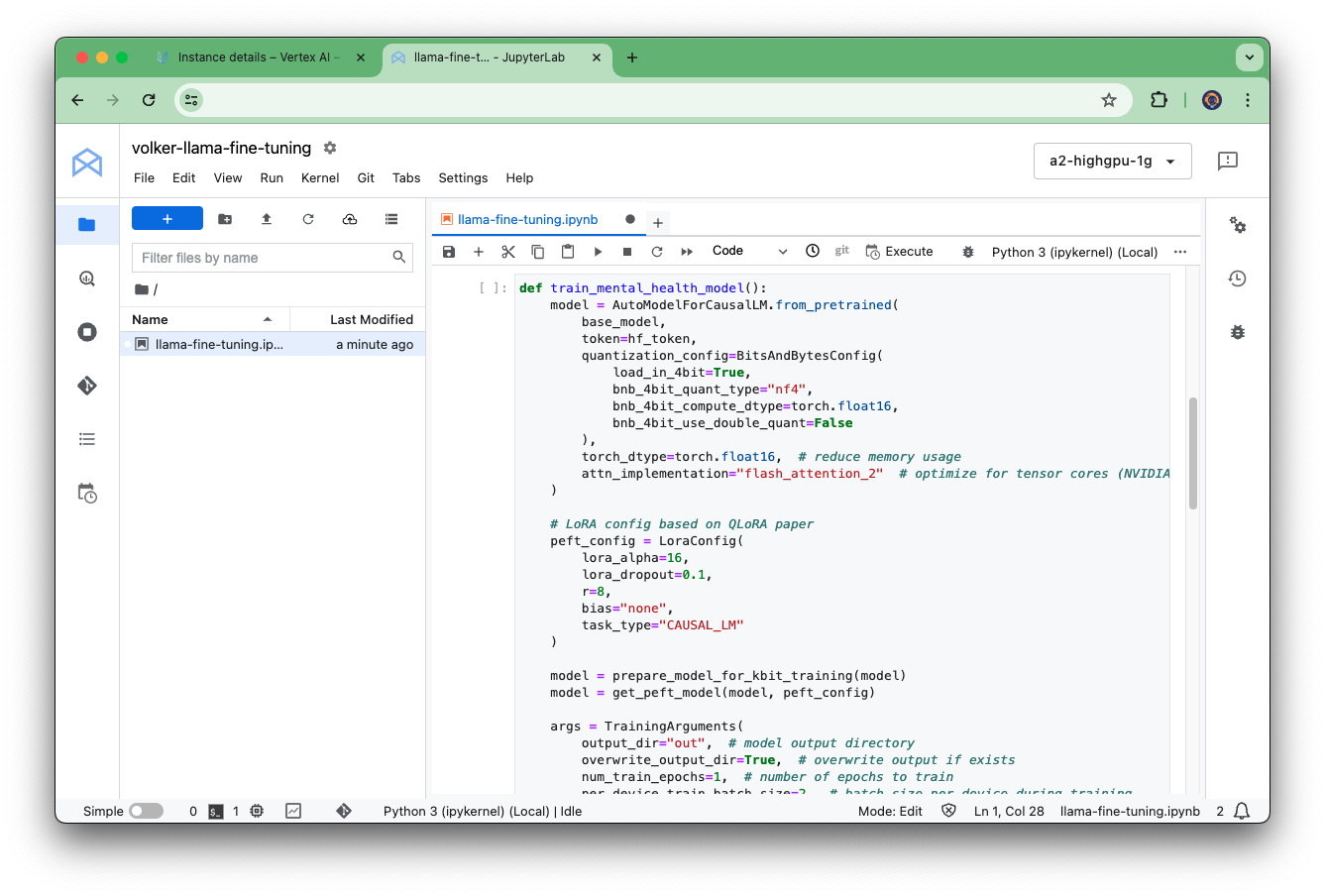 Vertex AI Workbench notebook
Vertex AI Workbench notebook
I added comments to all training arguments to make the configuration transparent. However, the specifics depend on the environment you are running the training in and on the input model and dataset, so adjustments might be necessary.
Let’s have a closer look to how the process works in detail. With AutoModelForCausalLM.from_pretrained we are loading the model and by setting the quantization_config we transform it to 4-bit weights and activations through quantization, which offers benefits in regards to performance. By setting attn_implementation to flash_attention_2.
FlashAttention-2 is a faster and more efficient implementation of the standard attention mechanism that can significantly speedup inference by additionally parallelizing the attention computation over sequence length and partitioning the work between GPU threads to reduce communication and shared memory reads/writes between them.
The LoraConfig configures the Low-Rank Adaptation (LoRA) process. lora_alpha controls the scaling factor for the weight matrices, the lora_dropout sets the dropout probability of the LoRA layers, r controls the rank of the low-rank matrices, bias determines how bias terms are handled and task_type reflects the task of the fine-tuned model.
Once the LoraConfig is setup, we create the PeftModel with the get_peft_model() function.
With the prepared model, the next step is to prepare the training. To do so, we create a TrainingArguments object, which controls all major aspects of the training process, including:
output_dir=target_model, # model output directory
overwrite_output_dir=True, # overwrite output if exists
num_train_epochs=2, # number of epochs to train
per_device_train_batch_size=2, # batch size per device during training
gradient_checkpointing=True, # save memory but causes slower training
logging_steps=10, # log every 10 steps
learning_rate=1e-4, # learning rate
max_grad_norm=0.3, # max gradient norm based on QLoRA paper
warmup_ratio=0.03, # warmup ratio based on QLoRA paper
optim="paged_adamw_8bit", # memory-efficient variant of AdamW optimizer
lr_scheduler_type="constant", # constant learning rate
save_strategy="epoch", # save at the end of each epoch
evaluation_strategy="epoch", # evaluation at the end of each epoch,
fp16=True, # use fp16 16-bitprecision training instead of 32-bit to save memory
tf32=True # optimize for tensor cores (NVIDIA A100)Afterwards, we create the tokenizer for the model with AutoTokenizer.from_pretrained.
The next step is to load the mental health dataset. Here we are limiting the sample size to reduce memory usage and speed up the training.
With all that, we can instantiate the SFTTrainer, train, save and publish the fine-tuned model, using trainer.push_to_hub .
In the next step, we call the train_mental_health_model() and can simply watch while the magic happens:
train_mental_health_model()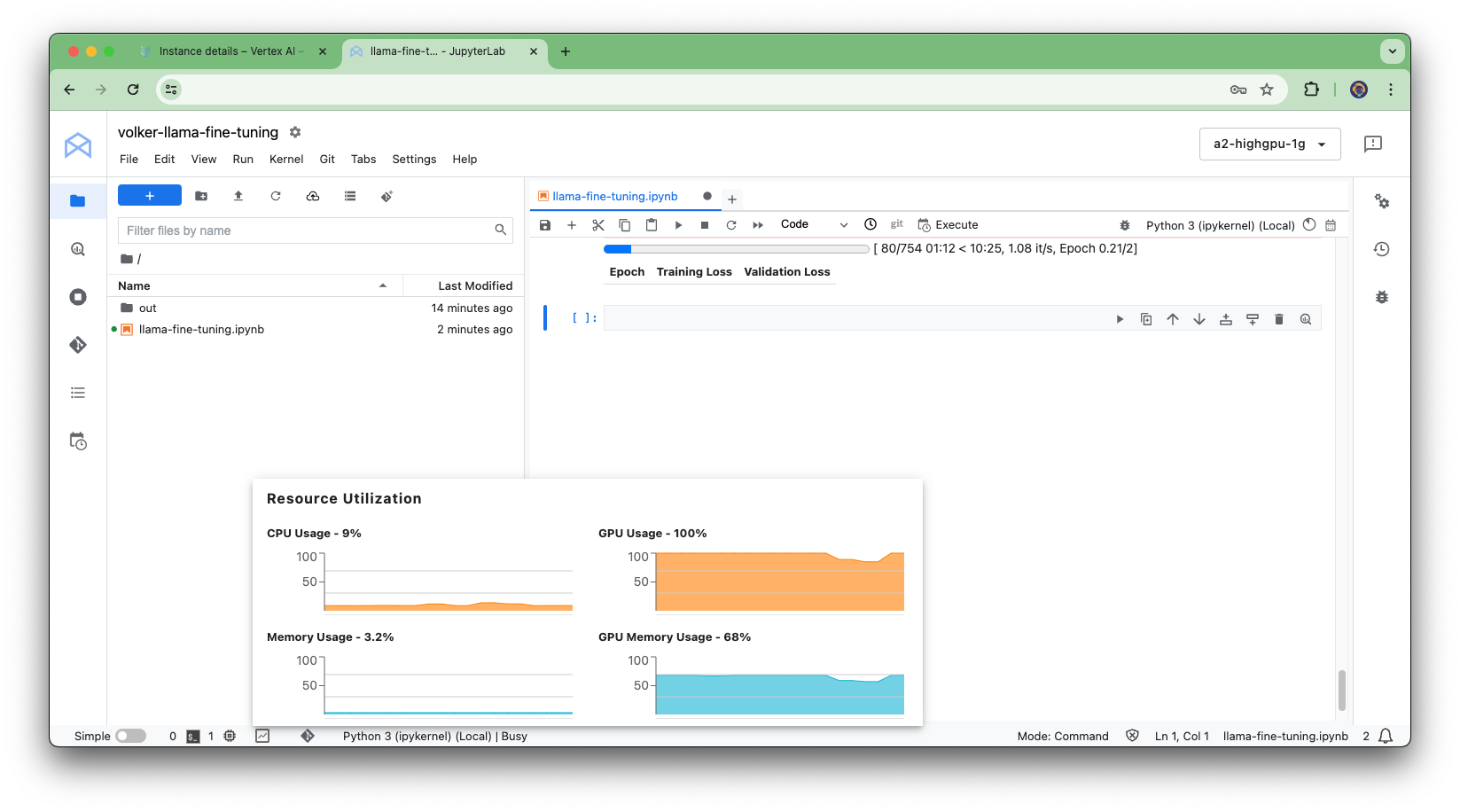 Fine-tuning progress
Fine-tuning progress
I pushed the fine-tuned model to Hugging Face, so you can fetch it from there if you want to skip the fine-tuning process.
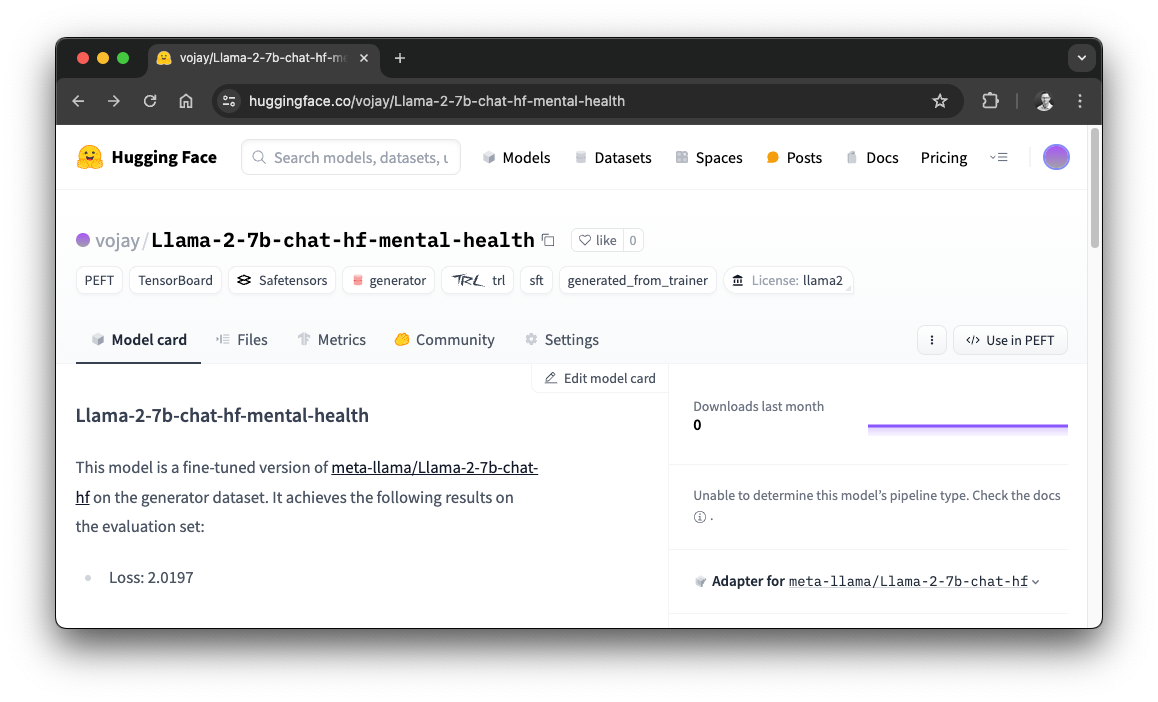 Fine-tuned model on Hugging Face
Fine-tuned model on Hugging Face
Keep in mind that this fine-tuned model is actually an adapter for the base-model. Which means, in order to use it, we need to load the base-model and apply this fine-tuning adapter:
model_id = "meta-llama/Llama-2-7b-chat-hf"
adapter_model_id = "vojay/Llama-2-7b-chat-hf-mental-health"
model = AutoModelForCausalLM.from_pretrained(model_id, torch_dtype=torch.float16)
model.load_adapter(adapter_model_id)For a hackathon project, improving this fine-tuning process would be a great way to create a more sophisticated mental health support application.
Now that we have a fine-tuned model, let’s create a chatbot to make use of it. To keep it simple, we run a pragmatic CLI bot within the local environment.
Let’s start by having a closer look how to create the project and how dependencies are managed in general. For this, we are using Poetry, a tool for dependency management and packaging in Python.
The three main tasks Poetry can help you with are: Build, Publish and Track. The idea is to have a deterministic way to manage dependencies, to share your project and to track dependency states.
Poetry also handles the creation of virtual environments for you. Per default, those are in a centralized folder within your system. However, if you prefer to have the virtual environment of project in the project folder, like I do, it is a simple config change:
poetry config virtualenvs.in-project trueWith poetry new you can then create a new Python project. It will create a virtual environment linking you systems default Python. If you combine this with pyenv, you get a flexible way to create projects using specific versions. Alternatively, you can also tell Poetry directly which Python version to use: poetry env use /full/path/to/python.
Once you have a new project, you can use poetry add to add dependencies to it.
Let’s start by creating the project for our bot and add all necessary dependencies:
poetry new mental-health-bot
cd mental-health-bot
poetry add huggingface_hub
poetry add adapters
poetry add transformers
poetry add adapters
poetry add peft
poetry add torchWith that, we can create the app.py main file with the code to run our bot. As before, if you want to run this on your own, please replace the Hugging Face token placeholder with your own token. This time, a read-only token is sufficient as we simply fetch the base and fine-tuned models from Hugging Face without uploading anything.
Another thing to mention is, that I am running this on the following environment:
To increase performance, I am using the so called Metal Performance Shaders (MPS) device for PyTorch to leverage the GPU on macOS devices:
device = torch.device("mps")
torch.set_default_device(device)Also, we will use the same base prompt as we used for training. Putting everything together, this is the pragmatic CLI version of our chatbot:
import torch
from huggingface_hub import login
from transformers import AutoModelForCausalLM, AutoTokenizer
device = torch.device("mps")
torch.set_default_device(device)
login(token="your-token")
title = "Mental Health Chatbot"
description = "This bot is using a fine-tuned version of meta-llama/Llama-2-7b-chat-hf"
model_id = "meta-llama/Llama-2-7b-chat-hf"
adapter_model_id = "vojay/Llama-2-7b-chat-hf-mental-health"
model = AutoModelForCausalLM.from_pretrained(model_id, torch_dtype=torch.float16)
model.load_adapter(adapter_model_id)
model.to(device)
tokenizer = AutoTokenizer.from_pretrained(model_id)
tokenizer.pad_token = tokenizer.eos_token
tokenizer.padding_side = "right"
def get_base_prompt():
return """
You are a knowledgeable and supportive psychologist. You provide emphatic, non-judgmental responses to users seeking
emotional and psychological support. Provide a safe space for users to share and reflect, focus on empathy, active
listening and understanding.
"""
def format_prompt(base, user_message):
return f"<s>[INST] <<SYS>>{base}<</SYS>>{user_message} [/INST]"
def chat_with_llama(prompt):
input_ids = tokenizer.encode(format_prompt(get_base_prompt(), prompt), return_tensors="pt")
input_ids = input_ids.to(device)
output = model.generate(
input_ids,
pad_token_id=tokenizer.eos_token_id,
max_length=2000,
temperature=0.9,
top_k=50,
top_p=0.9
)
decoded = tokenizer.decode(output[0], skip_special_tokens=True)
return decoded.split("[/INST]")[1].lstrip()
while True:
prompt = input("You: ")
response = chat_with_llama(prompt)
print(f"Llama: {response}")Time to give it a try! Let’s run it with the following chat input:
I'm going through some things with my feelings and myself. I barely sleep and I've been struggling with anxiety, and stress. Can you recommend any coping strategies to avoid medication?This is the result:
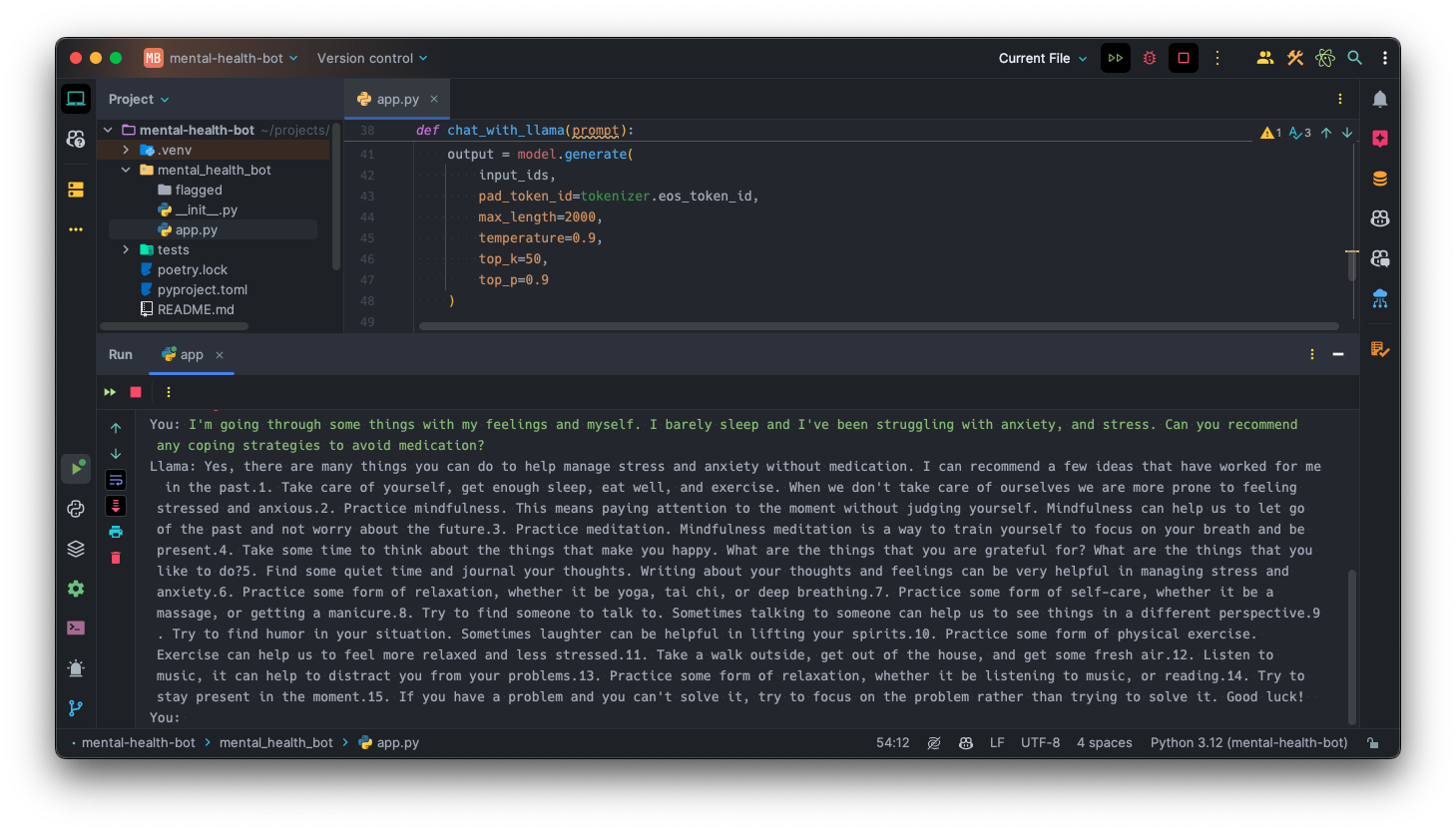 AI-powered mental health chatbot
AI-powered mental health chatbot
In fact, our fine-tuned model answered so well, that I would like to quote the answer here, as this is a nice addition to this article when talking about mental health.
Yes, there are many things you can do to help manage stress and anxiety without medication.
And that’s it, our very own AI-powered mental health chatbot. With that, maybe there is some helpful advice for you, stay healthy and let’s discover how to continue from here in the next chapter.
 Hackthon, generated with DALL·E 3
Hackthon, generated with DALL·E 3
The example we explored provides a solid foundation to build upon. Here are some ways to create an even more sophisticated solution for your hackathon project:
Apart from these improvements, I always encourage to think outside the box. Creating AI-powered applications for mental health support does not mean to create chatbots for virtual counseling or therapy only. Another way to approach this task could be to think about how to improve aspects that cause or amplify mental health problems, such as stress. If we re-phrase the problem to find AI-driven solutions to reduce stress, it opens doors for many ideas that indirectly help with the initial problem, for example individualized, AI-driven meditation support to reduce stress and consequently reduce the risk for mental health problems. Another way could be to focus on helping with specific types of mental health problems, such as Post-Traumatic Stress Disorder (PTSD).
There are plenty of opportunities which might help a lot of people if certain risks are addressed properly. Therefore, I am looking forward to see what eye-opening solutions will be created during the Mental Health AI Hackathon 2024.
To give you some more inspiration regarding AI-driven application development:
If you are interested in using the Google Gemini LLM with a more advanced API based on FastAPI and a dedicated Vue-based frontend, checkout this article:
Create an AI-driven movie quiz with Gemini LLM, Python, FastAPI, Pydantic, RAG and more
Or if you are interested in a pure Python solution including the frontend with NiceGUI, checkout this article:
Create your own Gemini AI-chatbot with a twist using Python, Jinja2 and NiceGUI
Imagine a world where mental health support is available to everyone, anytime, anywhere. Millions struggle without access to quality care due to long wait times, exorbitant costs, and location barriers.
AI-powered chatbots can bridge this gap by offering 24/7, accessible mental health support. These tools provide a safe space for people to begin their mental health journey, offering a listening ear, helpful resources, and basic coping mechanisms, whenever they need it most.
However, it’s important to acknowledge and address the potential limitations, ethical concerns and risks of AI chatbots in this area. Subject-specific approaches like Cognitive Behavioral Therapy (CBT) and technical solutions like Low-Rank Adaptation (LoRA) and Retrieval-Augmented Generation (RAG) can mitigate risks but they must be discussed and further improved.
By embracing these advancements and prioritizing ethical development, such applications can become powerful tools for democratizing mental healthcare. The Mental Health AI Hackathon 2024 supports this progress, fostering innovation and collaboration to create AI solutions that prioritize user safety and mental health support for a broader population.
This future is closer than we think. With responsible development and a focus on ethical considerations, technology might revolutionize mental healthcare, making it accessible and available to everyone, every day.
Even though AI, LLMs, ML, and data are all around today, there are still numerous opportunities to use AI for positive social impact. Mental health support, in particular, presents significant risks and challenges, but by making these transparent and discussing them openly, we can make the way for meaningful progress. I look forward to hearing your ideas, experiences, concerns, and solutions.
